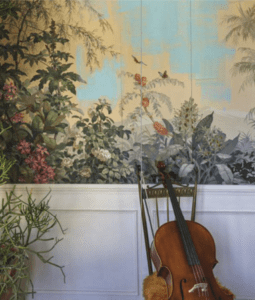Source: Francesco Risso | Sept- Oct 2021
The home of Francesco Risso, creative director of Italian fashion house Marni, is in a handsome early-20th century Milan building located in the city’s centre. The facade is an elaborately embellished succession of decorative walls and columns, and once inside the impression is even wilder: a dizzying myriad references and images together with Palaeolithic paintings from the Lascaux caves, influences from the 1970s but also Art Deco, the Bronze Age palace of Knossos in Crete, Tibetan craftsmanship and Op Art. “I’ve been here since December 2019, and my home is constantly evolving,” says Risso, who completed renovations on the three-bedroom apartment this February.“There
are rooms that I have repainted seven times. I let myself be guided by instinct, by the feeling that comes to you from the four walls around you.”
Instinct also played a role in the choice of the apartment itself: “I liked its strange horseshoe layout, without the classic corridor leading from room to room,” says Risso. “It reminds me of houses in Genoa, my hometown, because it is rather delirious, with a classic imprint but full of irregularities. There’s a feeling of returning to my origins. I’m a big fan of Genoese houses. Even from the outside this is a fantastic building: well kept but with the patina of time.”

The renovation began with the 1950s pastel blue, green and pink walls being the first to go. “When I put my cacti in the living room, I felt like I was in Santa Fe,” says Risso. “We did everything we could to remove that effect and achieve something a little more mysterious by creating a 1930s ambience with darker hues.” The highly decorative result was a collaborative production with the interior designer Ludovica Saviane and a mutual friend. At first, says Risso, Saviane was terrified of such a bold intervention as the house was of historical importance. “But I told her in every way, she had to go freehand. The recipe is just that, to warm up the spaces with natural instinct.”
To tone down the original hues, Risso moved towards deeper shades of ochre, blue, deep red and vibrant greens — along with many patterns. “A flat-painted wall gives me sadness and anxiety,” he says. “I don’t like ‘perfection’. I like to humanise everything, even when it comes to clothing. Nothing should remain intact, finished. It’s the opposite of precision.”
The refresh focused on certain details that then inspired further expansion: “First the curtains, then some of the walls. In the end, I just decided to repaint the entire house,” says Risso. The furnishings reflect the same train of thought, and are, once again, a matter of instinct. “Take the sofa in the living area: I began with the colour. I wanted black, so it would feel more like a squat than an elegant home in contrast with the pomp of the very high doors.” When it comes to design, Risso prefers to surround himself with works that bear history’s mark. “I’m open to anything, from prehistoric times to the 1970s,” he says. “I like to distort objects from the past, to take them and reassemble them anew. Among the contemporaries, I very much admire the work of Martino Gamper — he too likes to disrupt objects from the past.”
For Risso, a home is a place to share — a personal vision, which was mirrored in the online presentation for
Marni’s autumn/winter 2021 collection when the designer transformed a home interior into a dream-like garden full of musicians, models and performers. “It was thrilling for musicians who had not played in public before, but also
thrilling for us,” he says. “It was a circus, a cabaret: all the furniture moved and in the kitchen, which we turned into a vegetable garden, there was a floor made of real grass… it was the dream of my kitchen. In the end it wasn’t that different from how I live in my own house every day and every night.”
It’s this fantastical ideal of escapism and freedom that guided Risso in his choice of furniture and objects, many of which came from renowned Milan gallerist Nina Yashar — “a friendwhose taste I have always admired,” says Risso. Other pieces like a chaise longue — an anthropomorphic, surrealist tartan creation made by set designer Mario Torre, which the creative director keep to a whole new level. When asked if he has any plans on how his home might evolve in the future, Risso says, “Who knows? When we can go out again, and start living the Roaring Twenties, I will probably have to clean everything up and turn it all to white.”
